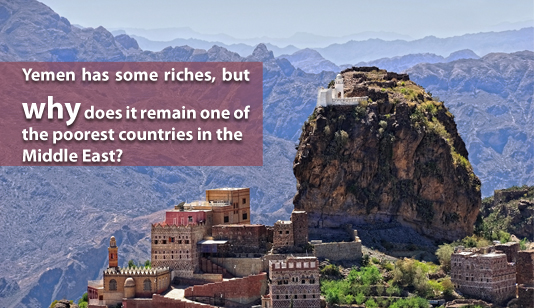Doing Business in the Middle East:
Yemen: why does it remain one of the poorest countries in the Middle East?
Yemens islands are scattered in the Red Sea, parallel to the coast. Kamaran is largest and most significant inhabited island and has exceptional wildlife and plant species. Mayoon Island (Breem) has a strategic importance due to its location, as it controls the strait of Bab Al-Mandab. Other islands in the Arabian Sea are located more closely together. Soqatras archipelago is the most famous for being the home of the dragon tree, span wood, and some unique trees of significant medicinal and economic value.
The archipelago consists of a group of islands (Soqatra, Abdu Alkuori, Siyal Abdu Alkuori, Siyal Soqatra) and rocks (Sirah, Adlah, Sayhar, Jalis, Radad, Karshah and Dhain Dhatil).
As for climate, Yemen is hot and humid along its coast, moderate in the mountains, and has a desert climate in its desert areas. Rain falls during the whole year varying in quantity from season to season, reducing in Winter and increasing during Spring and Summer. Peak rainfall happens during the months of June, July, and August.
There are six cultural and economic zones. The Tihama, a coastal plain and hilly area along the Red Sea, is an area of fishing, commerce, and trade at the ports of al-Mukha (Mocha) and al-Hudayda. Agricultural oases produce crops such as millet, maize, sugarcane, watermelons, tobacco, and cotton as well as rearing livestock. Handicrafts are made in Zabid, Bayt al-Faqih and other regional centres.
In the west, millet, wheat, barley, grapes, coffee, tobacco, vegetables, fruits, and qat are grown on terraces, with goats, sheep, cows, and donkeys bred locally. The central mountains consist of wide plateaus and basins. Fields are watered from wells and rainfall is sufficient for most crops. This region includes urban centres such as Sanaa and Sada. The high plateau in the east gradually merges with the desert Rub al-Khal. Date palms are cultivated in small oases, and the population is semi-nomadic. There are salt deposits near Shabwa, Safir, and Harib. The limestone area of Hadhramaut and Wadi Masila has valleys (wadis) carved deep into the plateau. Cultivated patches are irrigated by rain, floodwater and wells. Hinterland towns include Shibam, Sayun, and Tarim in the Inner Wadi, and there are seaports at al-Mukalla and al-Shihr. The adjacent Mahra province and Socotra Island are culturally related to this zone.
The name of the country is derived from the legendary ancestor Yaman, the son of Qahtan, or from the Arabic root ymn (the right) since Yemen is located to the right of the Meccan sanctuary of Kaaba. Some scholars compare the Arabic word yumna (happy) with the Roman name for southwest Arabia, Arabia Felix (Happy Arabia). Inhabitants feel that they have a common culture, although local and class identities are still important.
As stated by the World Bank, Yemen’s economic recovery is still vulnerable. After the country slipped into recession in 2011 with Gross Domestic Product (GDP) shrank by 12.7%, the economy is estimated to have grown by 2.4% in 2012. Whereas the budget deficit widened to 6.2% of GDP in 2012, the current account deficit narrowed to about 1% of GDP. Three US$1 billion oil grants from Saudi Arabia helped stabilise the overall macro-economic situation. Economic prospects will depend on progress on the political and security fronts, continued donor support, and the implementation of critical reforms. Yemen suffers from large gender disparities, with significant gaps in women’s access to economic, social and political opportunities. Female participation in the labour force is considered as one of the lowest in the world. Early marriages have an enormous effect. Social development indicators, such as child malnutrition, maternal mortality, and educational attainment remain discouraging.
Local Yemeni press criticise the international media who continually label Yemen as the “poorest country in the region”.
Poverty, which was already increasing prior to the latest political crisis, is estimated to have risen further from 42% of the population in 2009 to 54.5% in 2012. Moreover, for a country of 23,491,859 people and 482,100 square km surface area, it has a 17.8% unemployment rate. The rate of participation in economic activity is 39.5%: for males 68.4% and females 10.1%, one of the lowest for women in the world.
Yemen has one of the highest population growth rates in the world, while being one of the most food insecure countries globally. Approximately 45% of the population is food insecure and Yemen’s scarce water resources are far below the regional average.
Middle East Business wanted to look at three of Yemen’s well known products – Agate, Qat and Coffee – to see how this mix affected the economy.
Yemeni Agate
When reading statistics or looking at the press, one might come to the conclusion that Yemen is almost the poorest country in the world. But once one glimpses the beautiful resilient nature of Sana’a and its surrounding cities, one might change one’s mind.
San’a, capital of Yemen, has UNESCO World Heritage Site status and is described by many architects as “the amazing city of mud”. The fact that its multi-level and truly decorative buildings were created from pressed earth simply adds to the beauty of the place.
While Yemen may be experiencing economic difficulties, it is considered as having many important natural resources amongst which is the precious stone, agate.
According to Al Ryad newspaper, the production of Agate in Yemen is still an important activity for many families as a craft passed down since ancient times. It currently generates employment for low-income families. This skill compensates for the scarcity of job opportunities in the labour market and reduces the overall rate of unemployment.
Agate stone has been famous since ancient times in the region. It is extracted from the mountains and then polished. Some of the stones are dark green, brown and many other colours. These precious stones, considered as being noble, compete with gold and silver. On a social level, people who wear agate are seen as being of a higher social rank.
This stone is mined currently and historically in the area of Anse Dhamar, 100 km south of the capital Sana’a and the province of Sana’a and Taiz Governorate, 252 kilometers north of Sanaa, Aden and Mukalla and Hadramout (south of Sana’a) throughout these mountainous areas. The production of this art form remained limited to certain families throughout the generations (for example the families of Haj Ali Abu Talib and Mohamad Lutof Almobanen), as well its secrets. And since this industry is a job creator and a national symbol, the Yemeni government has created a national centre to train specialists who work with this beautiful stone.
Khaled San’aani, a handcraft producer working with Agate, explains his processes following the extraction of the raw stone. He places it in a rocky pot and covers it with white paste and water and places it on the fire for a specific period of time to achieve the brightness. Once this is done, it is cleaned of its impurities and dust.
What is Agate?
Agate is a microcrystalline variety of silica, chiefly chalcedony, characterised by its fineness of grain and brightness of colour. Although agates may be found in various kinds of rock, they are classically associated with volcanic rocks and can be common in certain metamorphic rocks.
Agate is one of the most common materials used in the art of hard stone carving, and has been recovered at a number of ancient sites, indicating its widespread use in the ancient world. Most agates occur as nodules in volcanic rocks or ancient lavas where they represent cavities originally produced by the disengagement of volatiles in the molten mass which were then filled, wholly or partially, by siliceous matter deposited in regular layers upon the walls. Agate has also been known to fill veins or cracks in volcanic rock. Such agates, when cut transversely, exhibit a succession of parallel lines, often of extreme tenuity, giving a banded appearance to the section. Such stones are known as banded agate, riband agate and striped agate.
People in Yemen believe that agate is THE stone everyone should have for protection, to attract strength, and as protection from bad dreams according to traditional Yeminite folklore.
Qat
Yemeni people and their attitude to Qat – addictive substance or traditional way of life?
One of the usual scenes in Yemen is to see young people chewing what might one think is simply chewing gum. In fact, it is a plant called qat/al khat. Although it is a controversial subject, and this plant can be considered as illegal in some countries, but in Yemen it is common practice and chewed openly. Middle East Business asked the manager of a foreign NGO in Sana’a what he thought of this practice and its effects. He commented that chewing this plant slowed down all daily activity and possibly reduces productivity by at least 30%.
The figures dont lie
- 68% of men and 36% consume qat regularly.
- US$1,700,000,000 is spent on buying it.
- 28 million hours are wasted chewing it.
- 70% of Yemens water is consumed in its production.
The percentage of household income spent on qat increased during the crisis. Most Yemenis are habitual users; more than half of those who chew did so each day of the week. In 2010, the share of expenditure on qat by food-insecure households was 7.1%, which was almost as high as expenditure on health (7.3%).
In recent decades, qat production has become central to agricultural livelihoods in Yemen, and it is now estimated to provide employment to millions of workers.
It accounts for 6% of overall GDP and 33% of agricultural GDP. In 2009, research indicated that there were over 600,000 small-scale qat farmers in Yemen, which accounts for more than half of all small-scale farmers. In total, qat provides employment to one in seven working Yemenis (World Bank Qat report).
At one of East Africa’s largest airport hubs, Nairobi, Kenya, a large majority of flights to Europe regularly contain shipments of qat for overseas consumption by Ethiopians, Somalis and Yemenis. The leaves are packed so as to remain fresh for as long as possible, thereby retaining their potential sale value at their destination.
According to a report prepared by The Guardian newspaper, the mild herbal stimulant was categorised in the UK as a class C drug amid fears Britain could become a hub for illegal trafficking.
What is qat?
Catha edulis is a flowering plant traditionally used as a mild stimulant by the Ethiopian, Somali and Yemeni communities. Users chew its leaves and shoots which have natural compounds, including cathine and cathinone, that give a similar high to amphetamines.
Where is it grown?
Qat is native to north-east Africa and the Arabian Peninsula. It loses much its potency days after being picked. Once exported, qat costs about $US5 – 10 a bundle, and users can chew one or two bundles for up to six hours.
What are its effects?
Cathinone is a phenethylamine substance which induces mild euphoria and excitement similar to, but less powerful than, amphetamines. Users say qat can increase alertness and energy; others report a feeling of calm if it is chewed over several hours.
Is it harmful?
According to a drug education service in the United Kingdom, qat users can develop insomnia and short-lived confusion, high blood pressure, anxiety and aggression, palpitations and cardiac problems with heavy use. It warns: “As qat can cause periods of increased libido, care may be needed to minimise risks. Qat can inflame the mouth and damage the teeth, reduce appetite and cause constipation, and there is concern about a longer-term risk of development of mouth cancers”.
Qat can also exacerbate mental health problems and cause paranoid and psychotic reactions.
Its role in the economic, social, and political lives of people in the north and south of Yemen and certain clinical and psychiatric aspects have been studied at great length. For more information see this report: http://www.drugs-forum.com/forum/showthread.php?t=55317
What is the legal status of qat around the world?
It is illegal in the US and Canada and has been outlawed in most European countries, most recently by the Netherlands.
Coffee
Could Coffee Arabica be the light at the end of Yemen’s economic tunnel?
In order to strengthen its economic situation, Yemen is seeking to revive natural Arabic coffee production. Al Hayah newspaper published an article in February 2014 stating this could be the shining light of the economy. However, with the rise of qat plant production, any actual surface area available for coffee has been reduced dramatically. According to the article, around one million Yemenis currently work in coffee production.
It is well known that Yemen is the origin for Arabic coffee and home of Mocha coffee, named after the Mokha Port on the coast of the Red Sea. Yemen is considered the only country in the world where coffee trees are planted under environmental and climatic conditions different to those agricultural conditions normally associated with coffee production in other regions of the world.
It was the Portuguese, arriving on the western coast of Yemen in the sixteenth century, who tasted Yemeni coffee for the first time. The story goes that the sheikh of Mokha Port welcomed them and offered them a warm black energising drink – coffee.
The heyday of Yemen’s distinguished coffee didn’t last long. After only 300 years, regional competition left it without a future – and, most horrendous of all, is the growing trend of producing and consuming qat. This plant usurped coffee trees. In a direct comparison, in 2012 the planted area for coffee is 35,000 hectares, while qat occupied 163,000 hectares! 20,000 tonnes of coffee versus 191,000 tonnes of qat, which not only devours the available land but more worryingly consumes 70% of the country’s scarce water.
The most famous types of coffee are Mattari, Yafei, Haimi, Hirazi, Ismaili, Ahjuri, Mahweet, Buraai, Hammadi, Raimi, Wasabi, Anisi, Odaini, Sabri and Saadi.
Read more: https://middleeast-business.com/rich-but-poor-yemen-a-country-of-contradictions/




























